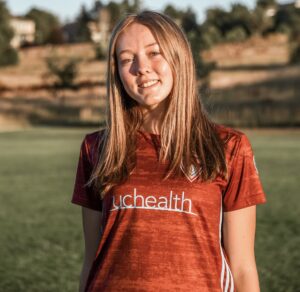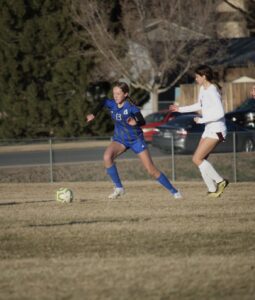
My name is Gracie Lambrecht and I have been living with type 1 diabetes for 12 of the 16 years of my life. Even though I lived for a few years T1D-less, I can’t remember a life without it and while I wish I could say it’s been a walk in the park to deal with, it most definitely has not. As a kid, the burden of pricking fingers, changing pump sites, and treating low blood sugars at midnight was not something that I was really tasked with handling. My parents took the responsibility of my diabetes care so I could be as “normal” of a kid as I could be. As I got older, I began taking more responsibility for my care and now, as a junior in high school, I completely manage my diabetes on my own.
As an extremely active high school student, finding time to do anything outside of class, mock trials, and competitive soccer is pretty difficult. Starting off, I want to say that no matter the final exam you have or the big game you might have coming up, your health ALWAYS comes first. Never procrastinate or ignore the needs of your T1D health for any reason and always prioritize taking care of yourself over everything else. While balancing school, sports, and T1D can be stressful at times, taking the right precautions and handling your diabetes care in the moment can make it easily manageable. I want to share, specifically how I manage playing soccer with type 1 diabetes.
I have been playing soccer since I was 4 years old. I actually started playing soccer just before I was diagnosed with T1D. I don’t remember much of that time in my life, but my mom knew something was wrong when I would only play for 5 minutes before begging to come off the field for water. After being diagnosed, I stopped playing soccer for a few years in order to better understand how to manage my T1D. After those years, I joined a club soccer team and haven’t stopped playing since. I currently play for the Colorado Rapids North ECNL- Regional League team. On this team, I have the opportunity to play against some of the toughest competition in the nation and the opportunity to be scouted by college soccer coaches. Most games that I play with this team involve at least an hour of travel when we play in Colorado, but we also travel out of the state to Utah, North Carolina, Florida, and other places. A usual week of training consists of:
-(3) 1.5 hour outdoor trainings
-(2+) 90 minute games
-Occasional strength training
In order to keep my blood sugars in a target range for playing (I feel most comfortable with my BG between 100-150), I not only make sure that I am eating the right foods in the right amounts, but I also utilize the exercise mode function on my Tandem (T-Slim) insulin pump. “Exercise mode” is a function on my pump that keeps my BG around 150 mg/dl by suspending insulin delivery when my sugars start to drop below 150. To go into further detail, for me, a typical game day looks like this (depending on the time of the game):
-3 hours before: I eat a large meal (with a good amount of protein and carbs). My favorite pregame lunch is a Turkey and Cheese sandwich with a small bag of chips and a cup of chocolate milk.
-1.5 hours before (30 minutes before warmups): I check my BG via my Dexcom G6 Continuous Glucose Monitor and if:
- Under 100: treat with 15 grams of sugar (I usually drink a 15g Apple Juice box) and go on Exercise mode for 3 hours.
- 100-150: Have a 15-20 gram snack (I would usually eat a granola bar) and go on exercise mode for 3 hours.
- Over 150: Go on exercise mode for 3 hours.
-10-20 minutes after the game: I check BG and have a snack/meal with protein to replenish nutrients (I like to drink a Nesquik Chocolate milk right after the game to hold me over until I can get a meal).
This plan is also very similar to how I prepare for a normal weeknight training session (minus eating a large meal 3 hours before).

Playing soccer is one of the most exciting and fun parts of my life and it has made me the person that I am today, just as my T1D has done the same. While it took some trial and error to find an effective way to manage my diabetes while playing soccer, recently keeping my blood sugars in a good range during soccer has been easier than ever. I understand that many people with T1D and their families may be worried about exercising with siabetes for the fear of having extremely low blood sugar. I am here to tell you that while low BG’s are always possible, with the right preparation, the chance of a low (or even high) BG can be minimized significantly. On my team, I play the center defensive midfield position which involves constant movement from box to box on the field. Even in this work-heavy position, I often play close to or the entire 90-minute game (with little breaks). Preparing for high and low blood sugars before the game allows me to play for this long without having to stop all the time to treat lows. I hope that by sharing my journey of playing competitive soccer with type one diabetes and sharing my care regimen for games/practices will help show anyone with T1D that with just a little preparation, you can do anything you dream of doing!





